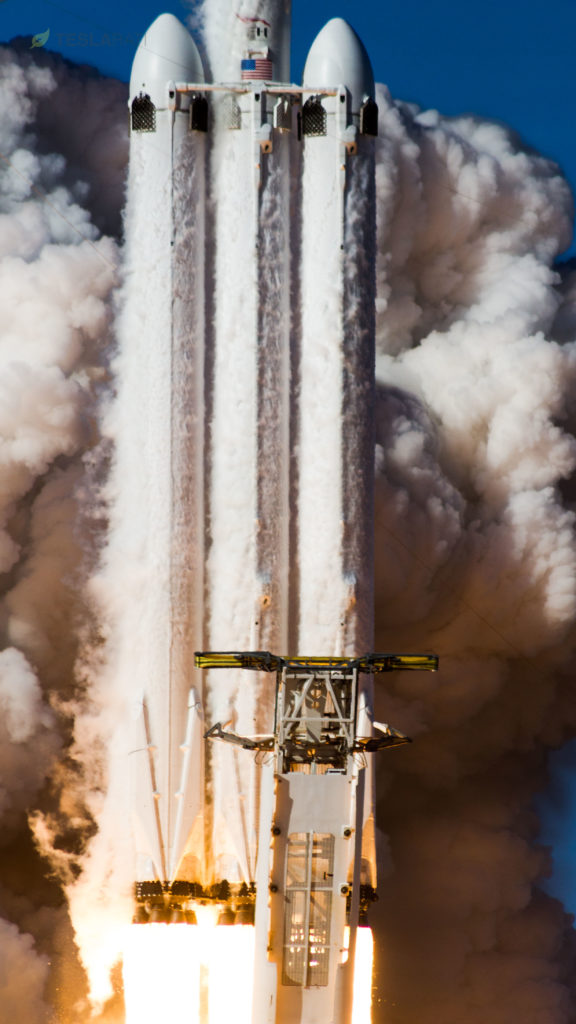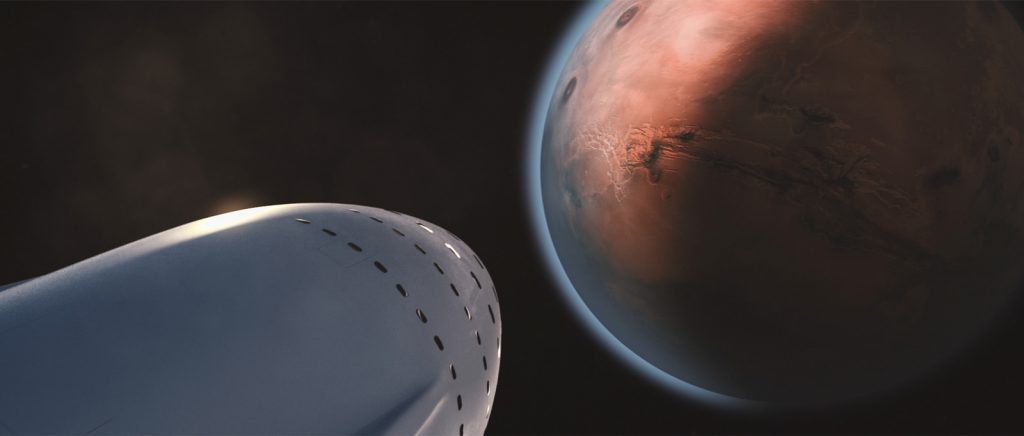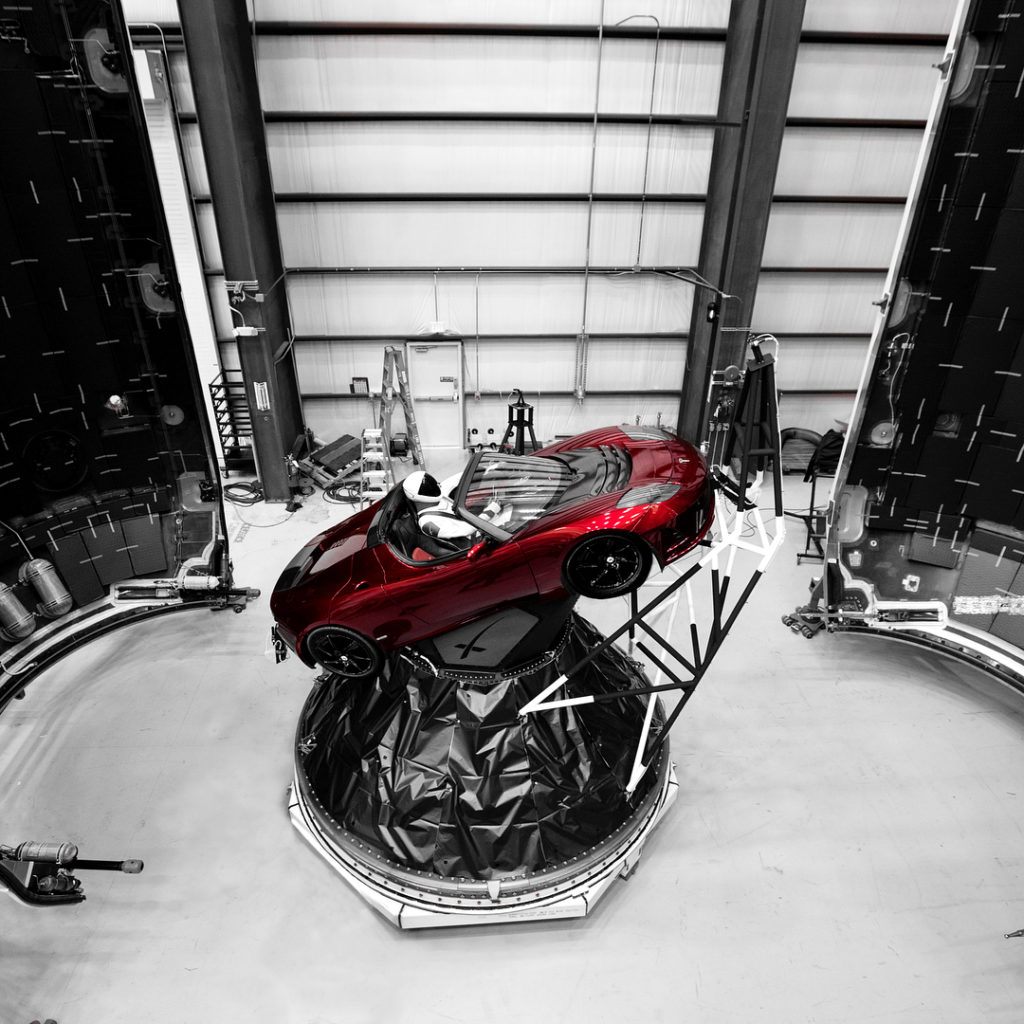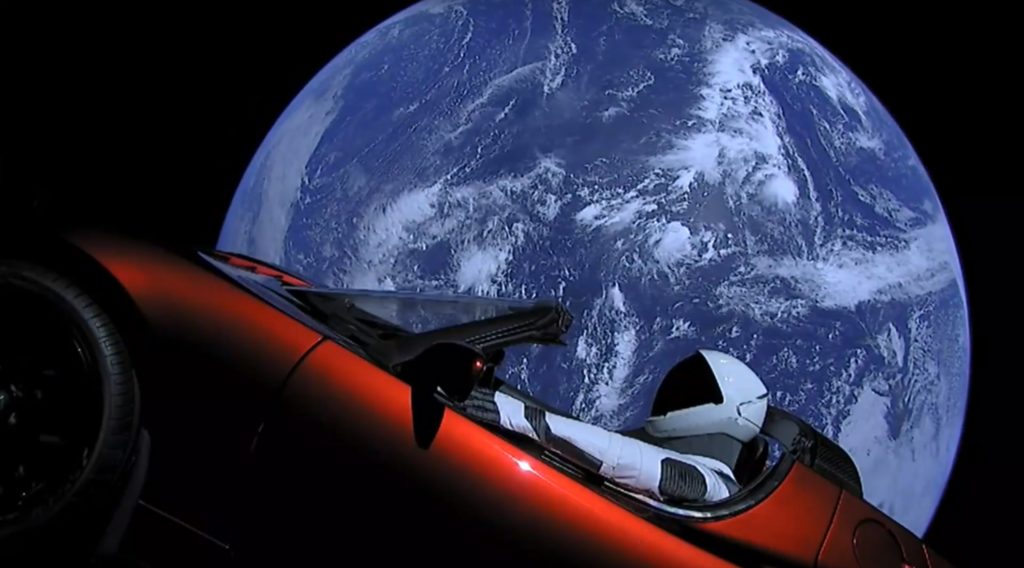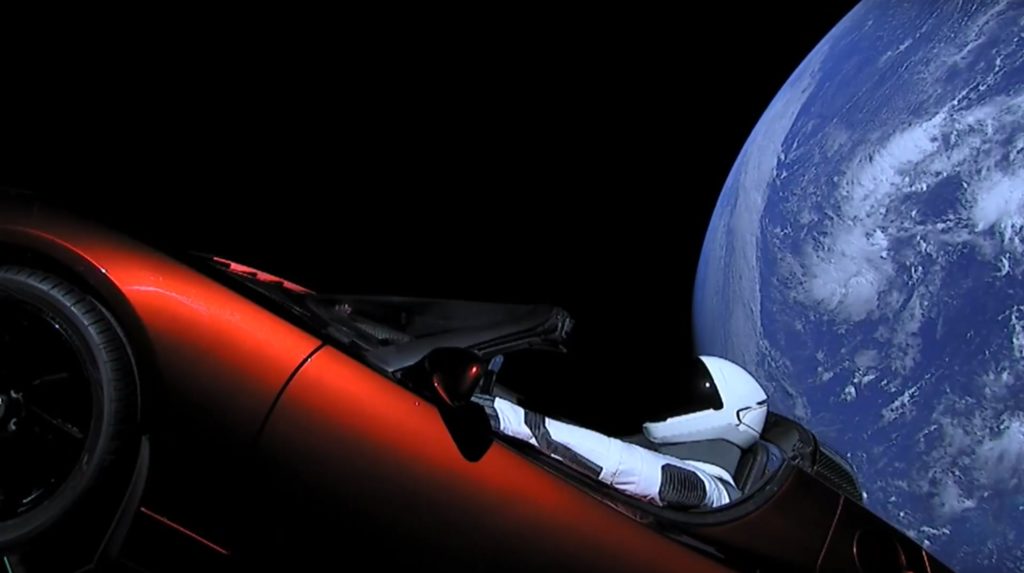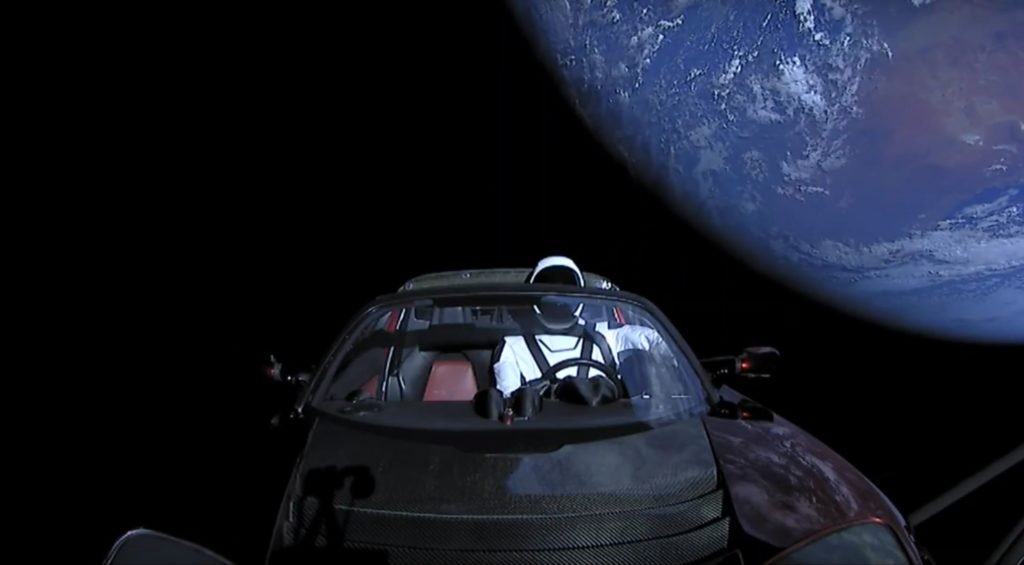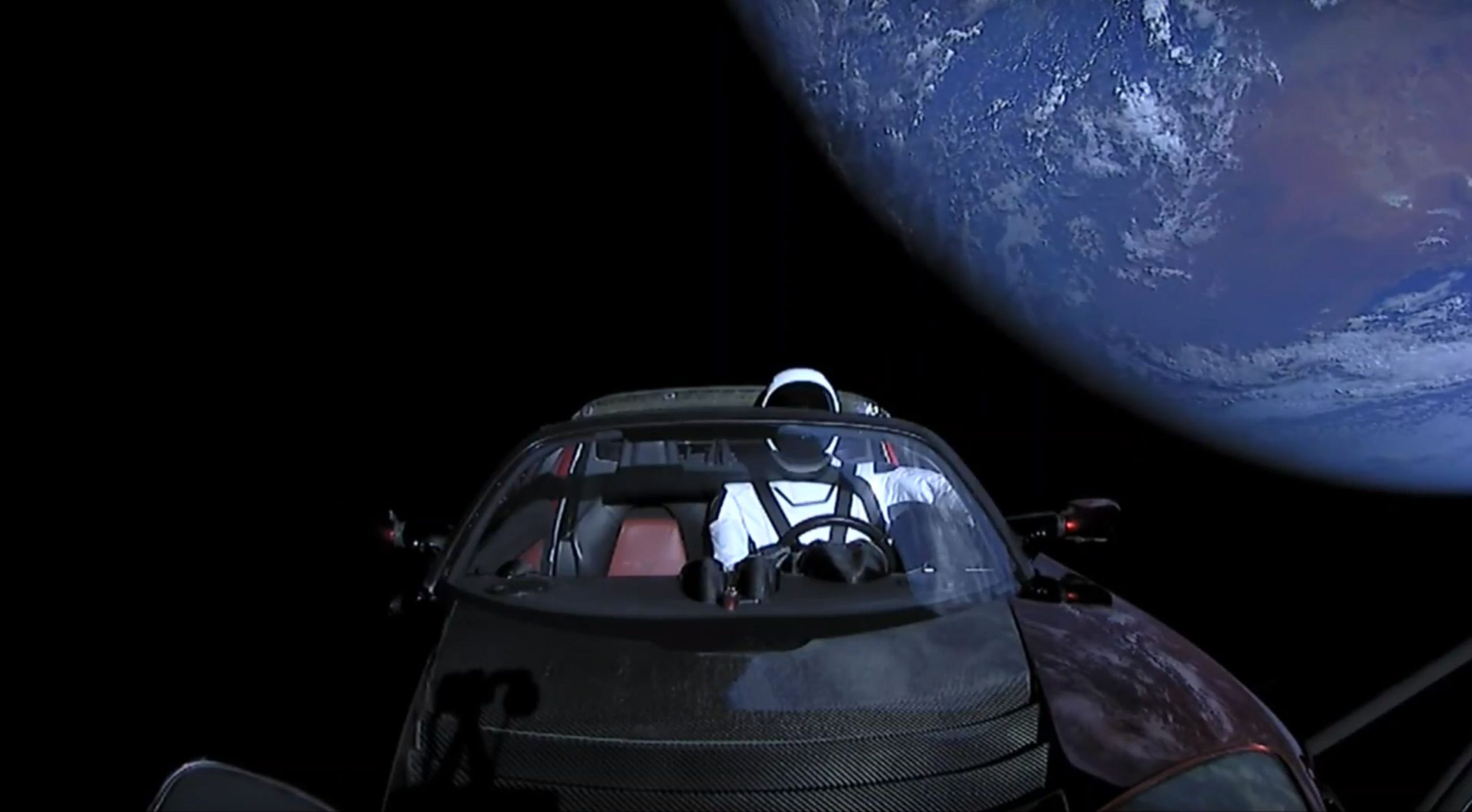
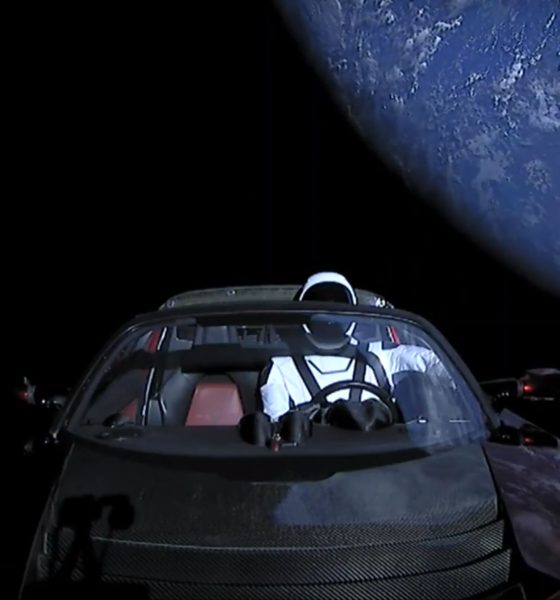
News
What will happen to Elon Musk’s Tesla on its space journey to Mars?
SpaceX has completed the last crucial step of Falcon Heavy’s inaugural test flight after successfully launching Elon Musk’s Tesla Roadster out of Earth’s orbit, on a trajectory into deep space. But what will happen to the car and ‘Starman’ as it makes its long journey to Mars? Let us explore the details.
Although Elon Musk indicated that the Tesla had been placed in an orbit that would nearly extend to the beginnings of the solar system’s first asteroid belt (on average more than 150 million miles away from Earth’s orbit), SpaceX updated that orbit estimate about 24 hours later and confirmed that the orbit was considerably closer to Mars’ orbit than the asteroid belt beyond the Red Planet.

Starman gives one final farewell to Earth as he departs for deep space aboard Musk’s Tesla Roadster. (SpaceX)
Understandably, the ultimate destination and state of the Roadster have been the source of an array of questions from those less familiar with interplanetary travel and orbital mechanics – most people.
How exactly does space travel work?
Before delving into the details, it’s crucial that I try to give everyone equal footing in the form of a basic understanding of what, how, and whens of spaceflight. To reach orbit, Falcon Heavy launched its Tesla payload horizontally. Once it rose vertically above the majority of Earth’s atmosphere, the rocket angled over until it was essentially thrusting parallel to Earth’s surface. Think of it like spinning a ball on a string: only after a certain speed will the ball successfully spin in a circle – spin too slow and the ball will simply fall. Reaching Earth orbit is very similar in concept: Falcon Heavy boosts the upper stage above Earth’s atmosphere, and the upper stage ignites and gains as much horizontal speed as possible.
All this time, both it and its Tesla payload are being pulled down by Earth’s gravity, but at a certain speed (8 kilometers per second, or ~18,000 mph), the rocket and its payload end up going faster around the Earth than its gravity can pull them down. A famous analogy can be found in a simple tennis ball: thrown normally, the ball will arc over and eventually fall to the ground. However, if a ball is thrown fast enough (and was also able to avoid being incinerated by friction against the atmosphere), one can imagine the ball going over the horizon, traveling around the Earth, and coming right back to the thrower.

Elon Musk walks among his recovered Falcon Heavy boosters at LZ-1 and 2. (Elon Musk)
Throwing a ball (or spaceship) into orbit
Amazingly, this becomes a far more reasonable proposition when dealing with asteroids, comets, and moons with much light gravity than Earth’s “1G.” For example, on Mars’ tiny moon Phobos, an astronaut could very nearly escape from the moon by running, and could almost effortlessly throw a ball fast enough to orbit Phobos (a blistering 25 mph would be required). Earth is just like that, just much, much, much larger, and with a thick atmosphere that both keeps us, humans, alive and also makes it quite a bit more difficult for us to get into orbit.
Back to Earth orbit. The first point of stability (when you are going faster forward than the Earth can pull you down) is called “low Earth orbit,” (LEO) being roughly the lowest height and velocity necessary to stably orbit the Earth. This is approximately where the International Space Station (ISS) is located (~ 250 miles above). Famously, astronauts and satellites at this altitude travel around the Earth once every 90 minutes, half in pure sunlight, half in the darkness of Earth’s own shadow – essentially a special sunrise and sunset every three-quarter of an hour.

Mars’ largest moon Phobos captured at the edge of the planet’s limb. Phobos is less than 15 miles in diameter. (ESA/Mars Express)
Now, expand that model of Earth and the Roadster in orbit around it to the entire solar system. In this model, Earth and all other objects are orbiting the Sun at different distances and speeds, like different bands of the same tree ring. The solar system is massive, however, and thus everything has to be scaled up: for example, the Earth orbits the Sun at 30 kilometers per second (~70,000 mph), nearly four times faster than our humble Tesla in LEO.
Remember: when orbiting Earth, objects are still under the firm hold of the planet’s gravity, but merely moving so fast that they are in a constant state of freefall. Take away the air, and being on the ISS is akin to skydiving, but if the skydive never ended. To truly escape Earth’s gravity and head to the Moon, Mars, or beyond, a rocket needs to go even faster still. In the case of the Roadster, this meant first speeding up to 8 km/s to reach a stable orbit around Earth, followed several hours later by one final burn that gave the payload another 3-4 km/s of speed. On the scale of the solar system, Roadster’s journey away from Earth can be thought of like, well, a Roadster making its way to the top of a steep hill. After climbing to the top, the Roadster is nearly out of energy but has just enough to accelerate as it begins its way down the other side. About six hours after launch, the rocket’s upper stage successfully crested the summit of Earth’s gravitational hill before rocketing down the other side, on its way to deep space, Mars, and beyond.
In essence, the rocket moved Musk’s Tesla from an orbit around Earth to an orbit around the Sun itself. Just as Earth takes 365 days (a year) to travel once around the Sun, the Roadster will complete an orbit of the sun every once in awhile, likely closer to the two Earth years it takes for Mars to complete its orbit. Similarly, evidenced by Earth and all the other planets in the solar system, orbiting the sun is typically very stable – humans do not exactly live in fear of the Earth falling into the sun, we just keep going around and around. Like the planets, Musk’s Roadster will almost certainly remain in its current orbit for millions of years – maybe even a billion years – quietly completing an orbit around the sun every two or so years for what is effectively an eternity on a human scale. Eventually, it’s possible that the Roadster and Starman will be pulled over time by the gravity of Earth in such a way that it reenters Earth’s atmosphere and burns up, but that is unlikely to happen for thousands of millennia.
Where is the Roadster headed?
The graphic tweeted by Musk serves as a good initial explanation of complex terms used to describe orbital mechanics. Because it is not circular, the orbit is known as elliptical, while the points closest to (perihelion) and furthest from (aphelion) the Sun also have their special names. The AU mentioned in the graphic refers to astronomical units, a standard measurement based upon the average distance between the Earth and the Sun – approximately 93 million miles. For comparison, a full trip around the Earth’s equator is a little less than 25,000 miles. Space is unfathomably immense.
Third burn successful. Exceeded Mars orbit and kept going to the Asteroid Belt. pic.twitter.com/bKhRN73WHF
— Elon Musk (@elonmusk) February 7, 2018
- Falcon Heavy explodes off of Pad 39A in a spectacle of fire, Roadster in tow. (Tom Cross)
- The Roadster’s orbit will reach out on one end as far as Mars, SpaceX’s ultimate destination as a company. (SpaceX)
Falcon Heavy’s upper stage appears to have simply burned until it ran out of fuel, and managed with the far end of its orbit at about 1.61 astronautical units (~250 million km) is considerably less than Musk’s pre-launch press conference suggestion that the Roadster was expected to end up in an orbit of 380 to 450 million kilometers.
Musk: If the third burn goes as we hope, the Tesla will get as far away as 380 to 450 million km from Earth.
— Eric Berger (@SciGuySpace) February 5, 2018
Is the Roadster going to Mars?
Sadly, the answer is a hard “no.” At most, the Tesla might have been sent into an orbit around the sun (heliocentric orbit) with a very close approach to Mars – a flyby, so to speak. It appears that SpaceX managed to get quite close to that original goal, and it is entirely possible that Starman’s Roadster could pass close to Mars at points along its orbit, although there will be no way to capture or transmit images from the Roadster.

While there will be no cameras to capture it, it looks like Starman could actually – one day – pass close to the Red Planet on his billion year journey. (SpaceX)
Perhaps most importantly, to launch the Roadster into such a high orbit, SpaceX had to ensure that the rocket’s upper stage could coast for multiple hours in Earth orbit and still be able to precisely reignite its Merlin Vacuum (MVac) engine for a final burn. By successfully accomplishing precisely that, SpaceX has taken a huge step towards being able to compete with the United Launch Alliance for all government and defense-related launch contracts, even those requiring direct placement into geostationary orbit (GEO), versus a slower but more common geostationary transfer orbit (GTO). Not coincidentally, that capability also means that SpaceX can efficiently send payloads beyond Earth orbit, as they have now done for the first time with Musk’s Tesla Roadster.
How long will it take?
Because the Roadster is not actually going to any planets, moons, or asteroids, it will never reach them. However, the electric car’s newfound orbital home means that it will at least be far, far from Earth – at points, it’s trajectory will cross closest to the orbits of Mars and Earth. It will take a minimum of several months for the Roadster to reach those distances, even at its blistering speed of 12 kilometers per second relative to Earth. Jonathan McDowell, a practicing astronomer, estimated that the Roadster would pass Mars orbit – to be clear, not arriving at Mars, simply reaching the same distance away from the Sun as Mars orbits – in July 2018, approximately five months from today.
Corrected orbital data for the Roadster: 0.99 x 1.71 AU x 1.1 deg
C3 = 12.0, passes orbit of Mars Jul 2018, aphelion November— Jonathan McDowell (@planet4589) February 8, 2018
What’s going to happen to Starman and the Roadster?
Soaring through the hard vacuum of deep space, not a whole lot can be expected to happen to Elon Musk’s Tesla Roadster and Starman. As mentioned, the high heliocentric orbit it was placed in will be incredibly stable, likely allowing the car to remain in deep space for tens of millions of years. Now, that is not to say that future human explorers millions of years from now would recognize whatever remained – deep space is characterized by a relatively extreme radiation environment that will not be kind to many components that make up the Roadster’s structure. Carbon fiber, plastic, leather, and paint all contain organic components that will be assaulted by an environment far harsher than that in and around Earth.
- Elon’s Tesla Roadster and his astronaut stand-in. (Elon Musk)
- . . . . . . . . yep. This is a thing, now. (SpaceX)
Still, hyperbolic claims that “Radiation Will Tear Elon Musk’s Rocket Car to Bits in a Year” are ridiculously exaggerated. Vacuum is characterized by the absence of anything, and that includes all conceivable methods of erosion. While high energy radiation found in deep space can and likely will shred the Tesla’s structural integrity and eventually bleach or discolor the car, the Roadster will be perfectly suspended in microgravity (basically zero gravity) conditions with almost no chance whatsoever of impacts by even tiny space debris like micrometeorites. If an aspiring car collector tried to recover the eccentric and historic trophy from space in several centuries/millennia, Roadster would very likely fall to pieces or even crumble to dust when moved or placed in an environment with any significant gravity. But, it will almost without a doubt retain its recognizable shape almost indefinitely, at least on a human scale. Starman can be expected to react very similarly.
hyperbolic claims that “Radiation Will Tear Elon Musk’s Rocket Car to Bits in a Year” are ridiculously exaggerated.
Finally, it appears that SpaceX has not installed any method of power generation or communication on Starman’s ride, meaning that humans likely saw their last views of the vehicle after SpaceX cut the live feed to Starman. This sadly means that there will be no photo ops with Starman soaring past Mars or exploring the asteroid belt, although that option will certainly be reserved for any future eccentric, Muskian test payloads.
Why does sending a car into deep space matter?
Ultimately, this final success is an invaluable cherry on top of what was already a stunning achievement. Without a single scrubbed launch attempt or unintended hold during the final countdown, SpaceX’s first launch of what is now the most capable operational rocket in the world was a perfect success in almost all regards. Although the massive rocket’s center booster failed to land aboard the drone ship Of Course I Still Love You (OCISLY) due to an apparent shortage of the chemical components used to reignite the booster’s engines, both side boosters were recovered on land with what can only be described as well-oiled expertise. Meanwhile, the rocket simply survived the launch in general, didn’t destroy the pad, successfully tested its unproven side booster separation mechanism, and launched an eccentric payload into the highest orbit yet achieved by the commercial launch company.
- It’s easy to understand why Musk himself laughed about Roadster looking very much like CGI. (SpaceX)
- Is this real life? Who knows anymore. (SpaceX)
- . . . . . . . . yep. This is a thing, now. (SpaceX)
In the case of Elon Musk, it certainly appears that it is possible to – at least once and awhile – have one’s cake and eat it too. Follow along live as launch photographer Tom Cross and I cover these exciting proceedings as close to live as possible.
Teslarati – Instagram – Twitter
Tom Cross – Twitter
Eric Ralph – Twitter

News
Tesla gamifies Supercharging with new ‘Charging Passport’
It will also include things like badges for special charging spots, among other metrics that will show all of the different places people have traveled to plug in for range.
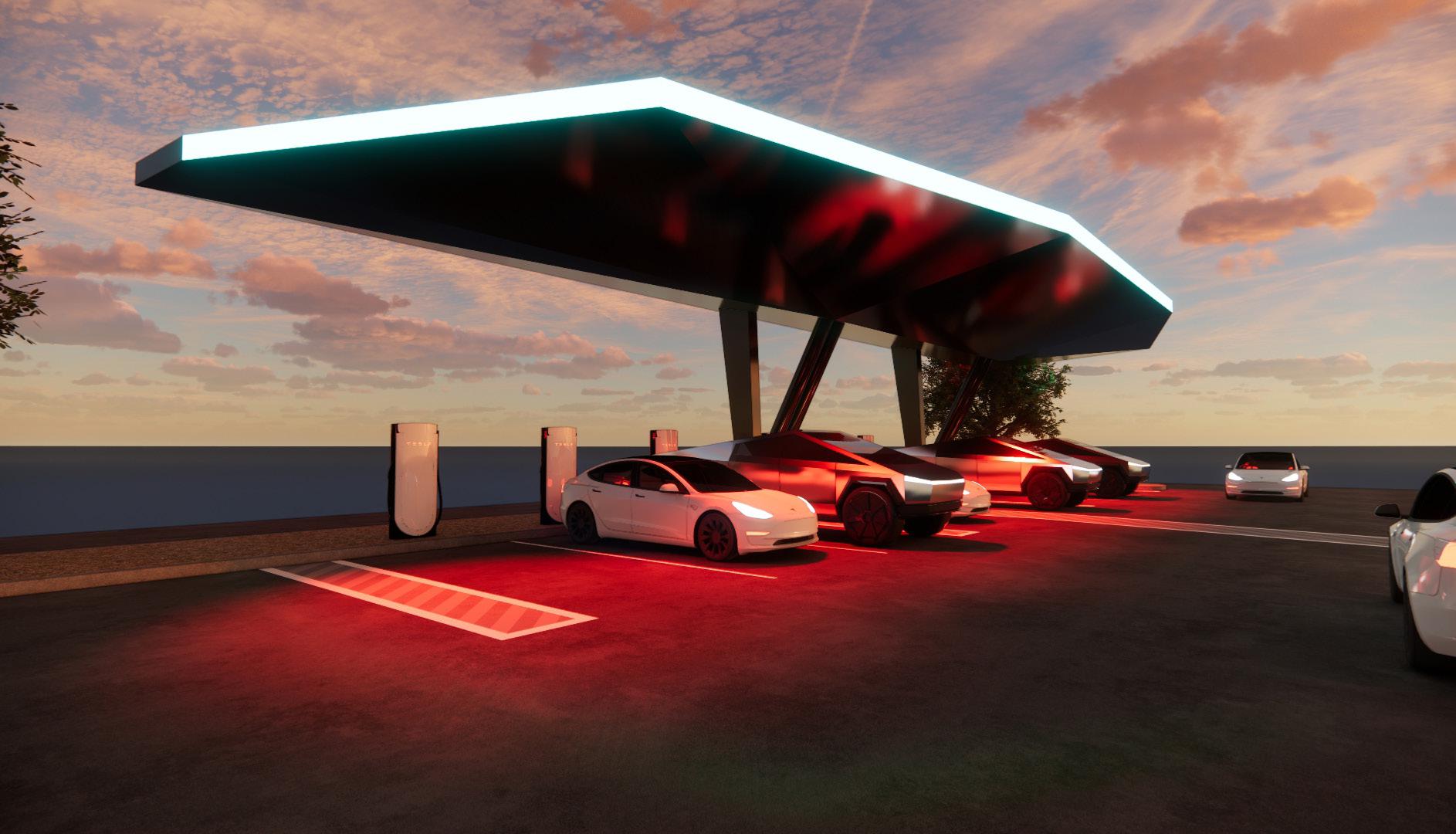
Tesla is gamifying its Supercharging experience by offering a new “Charging Passport,” hoping to add a new layer to the ownership experience.
While it is not part of the Holiday Update, it is rolling out around the same time and offers a handful of cool new features.
Tesla’s Charging Passport will be available within the smartphone app and will give a yearly summary of your charging experience, helping encapsulate your travel for that year.
It will also include things like badges for special charging spots, among other metrics that will show all of the different places people have traveled to plug in for range.
Tesla has just introduced “Charging Passport,” a new yearly summary of your charging.
• Charging badges: Iconic Charging badge (for visiting places like the Tesla Diner, Oasis Supercharger, etc), Explorer badge, green saver badge, etc.
• Total unique Superchargers visited
•… pic.twitter.com/c1DHTWXpj7— Sawyer Merritt (@SawyerMerritt) December 8, 2025
Tesla will include the following metrics within the new Charging Passport option within the Tesla app:
- Charging badges: Iconic charging badges for visiting places like the Tesla Diner, Oasis Supercharger, etc., Explorer Badge, and more
- Total Unique Superchargers Visited
- Total Charging Sessions
- Total Miles Added during Charging Sessions
- Top Charging Day
- Longest Trip
- Favorite Charging Locations
This will give people a unique way to see their travels throughout the year, and although it is not necessarily something that is needed or adds any genuine value, it is something that many owners will like to look back on. After all, things like Spotify Wrapped and Apple Music Replay have been a great way for people to see what music they listened to throughout the year.
This is essentially Tesla’s version of that.
With a handful of unique Superchargers already active, Tesla is also building some new ones, like a UFO-inspired location in New Mexico, near Roswell.
Tesla is building a new UFO-inspired Supercharger in the heart of Alien country
News
Tesla launches its coolest gift idea ever just a few weeks after it was announced
“Gift one month of Full Self-Driving (Supervised), which allows the vehicle to drive itself almost anywhere with minimal intervention.”

Tesla has launched its coolest gift idea ever, just a few weeks after it was announced.
Tesla is now giving owners the opportunity to gift Full Self-Driving for one month to friends or family through a new gifting program that was suggested to the company last month.
The program will enable people to send a fellow Tesla owner one month of the company’s semi-autonomous driving software, helping them to experience the Full Self-Driving suite and potentially help Tesla gain them as a subscriber of the program, or even an outright purchase.
Tesla is going to allow owners to purchase an FSD Subscription for another owner for different month options
You’ll be able to gift FSD to someone! https://t.co/V29dhf5URj
— TESLARATI (@Teslarati) November 3, 2025
Tesla has officially launched the program on its Shop. Sending one month of Full Self-Driving costs $112:
“Gift one month of Full Self-Driving (Supervised), which allows the vehicle to drive itself almost anywhere with minimal intervention. All sales are final. Can only be purchased and redeemed in the U.S. This gift card is valued at $112.00 and is intended to cover the price of one month of FSD (Supervised), including up to 13% sales tax. It is not guaranteed to cover the full monthly price if pricing or tax rates change. This gift card can be stored in Tesla Wallet and redeemed toward FSD (Supervised) or any other Tesla product or service that accepts gift card payments.”
Tesla has done a great job of expanding Full Self-Driving access over the past few years, especially by offering things like the Subscription program, free trials through referrals, and now this gift card program.
Gifting Full Self-Driving is another iteration of Tesla’s “butts in seats” strategy, which is its belief that it can flip consumers to its vehicles and products by simply letting people experience them.
There is also a reason behind pushing Full Self-Driving so hard, and it has to do with CEO Elon Musk’s compensation package. One tranche requires Musk to achieve a certain number of active paid Full Self-Driving subscriptions.
More people who try the suite are likely to pay for it over the long term.
News
Tesla expands Robotaxi app access once again, this time on a global scale
Tesla said recently it plans to launch Robotaxi in Miami, Houston, Las Vegas, Phoenix, and Dallas.
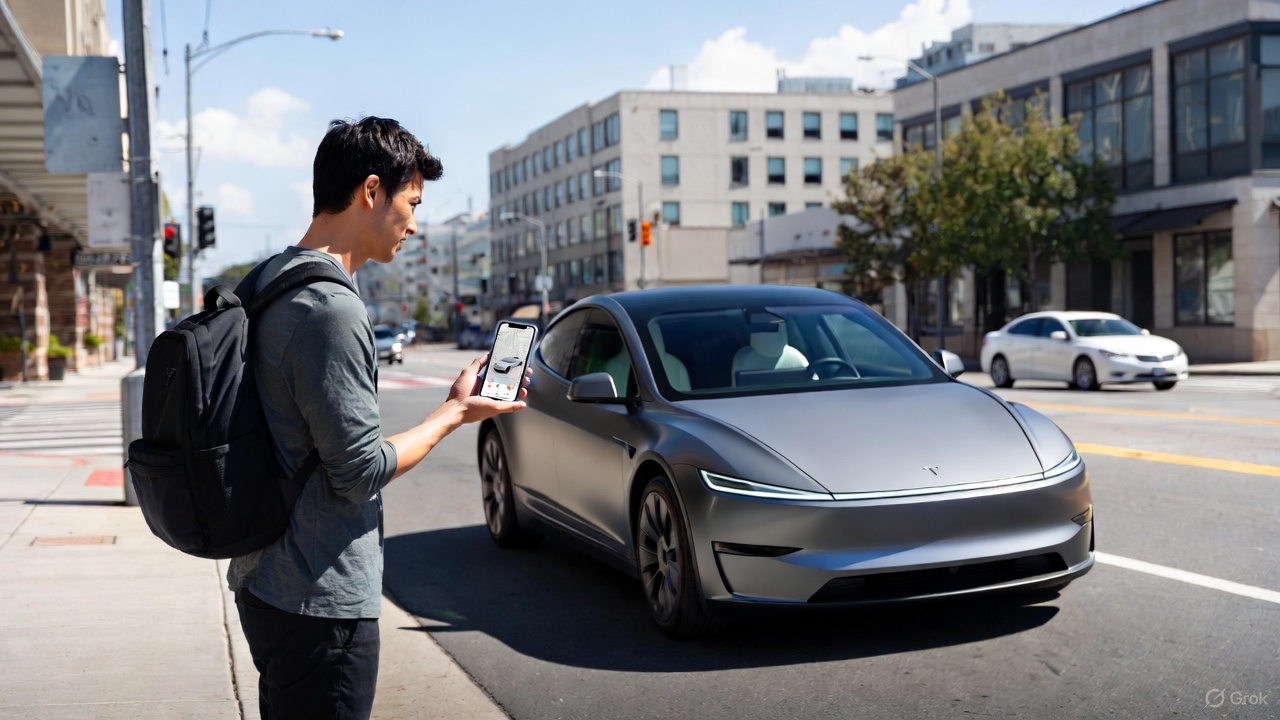
Tesla has expanded Robotaxi app access once again, but this time, it’s on a much broader scale as the company is offering the opportunity for those outside of North America to download the app.
Tesla Robotaxi is the company’s early-stage ride-hailing platform that is active in Texas, California, and Arizona, with more expansion within the United States planned for the near future.
Tesla said recently it plans to launch Robotaxi in Miami, Houston, Las Vegas, Phoenix, and Dallas.
The platform has massive potential, and Tesla is leaning on it to be a major contributor to even more disruption in the passenger transportation industry. So far, it has driven over 550,000 miles in total, with the vast majority of this coming from the Bay Area and Austin.
First Look at Tesla’s Robotaxi App: features, design, and more
However, Tesla is focusing primarily on rapid expansion, but most of this is reliant on the company’s ability to gain regulatory permission to operate the platform in various regions. The expansion plans go well outside of the U.S., as the company expanded the ability to download the app to more regions this past weekend.
So far, these are the areas it is available to download in:
- Japan
- Thailand
- Hong Kong
- South Korea
- Australia
- Taiwan
- Macau
- New Zealand
- Mexico
- U.S.
- Canada
Right now, while Tesla is focusing primarily on expansion, it is also working on other goals that have to do with making it more widely available to customers who want to grab a ride from a driverless vehicle.
One of the biggest goals it has is to eliminate safety monitors from its vehicles, which it currently utilizes in Austin in the passenger’s seat and in the driver’s seat in the Bay Area.
A few weeks ago, Tesla started implementing a new in-cabin data-sharing system, which will help support teams assist riders without anyone in the front of the car.
Tesla takes a step towards removal of Robotaxi service’s safety drivers
As Robotaxi expands into more regions, Tesla stands to gain tremendously through the deployment of the Full Self-Driving suite for personal cars, as well as driverless Robotaxis for those who are just hailing rides.
Things have gone well for Tesla in the early stages of the Robotaxi program, but expansion will truly be the test of how things operate going forward. Navigating local traffic laws and gaining approval from a regulatory standpoint will be the biggest hurdle to jump.
